Practice Test 4 - AP English Language and Composition
Section I
TIME: 1 HOUR
DIRECTIONS: Questions 1–13. Carefully read the following passage and answer the accompanying questions.
The passage is an excerpt from a book about the Mississippi River written late in the nineteenth century.
Passage 1
The Mississippi is well worth reading about. It is not a commonplace river, but on the contrary is in all ways remarkable. Considering the Missouri its main branch, it is the longest river in the world—four thousand three hundred miles. It seems safe to say that it is also the crookedest river in the world, since in one part of its journey it uses up one thousand (5)three hundred miles to cover the same ground a crow would fly over in six hundred and seventy-five. It discharges three times as much water as the St. Lawrence, twenty-five times as much as the Rhine, and three-hundred and thirty-eight times as much as the Thames. No other river has so vast a drainage-basin; it draws its water supply from twenty-eight states and territories; from Delaware on the Atlantic seaboard, and from all the country (10)between that and Idaho on the Pacific slope—a spread of forty-five degrees of longitude. The Mississippi receives and carries to the Gulf water from fifty-four subordinate rivers that are navigable by steamboats, and from some hundreds that are navigable by flats and keels. The area of its drainage-basin is as great as the combined areas of England, Wales, Scotland, Ireland, France, Spain, Portugal, Germany, Austria, Italy, and Turkey; and almost all this (15)wide region is fertile; the Mississippi valley, proper, is exceptionally so.
It is a remarkable river in this: that instead of widening toward its mouth, it grows narrower; grows narrower and deeper. From the junction of the Ohio to a point half-way down to the sea, the width steadily diminishes, until, at the “Passes,” above its mouth, it is but a little over half a mile. At its junction of the Ohio, the Mississippi’s depth is eighty-seven feet; (20)the depth increases gradually, reaching one hundred and twenty-nine just above its mouth.
An article in the New Orleans Times-Democrat, based on reports of able engineers, states that the river annually empties four hundred and six million tons of mud into the Gulf of Mexico—which brings to mind Captain Marryat’s rude name for the Mississippi—“the Great Sewer.” This mud, solidified, would make a mass a mile square and two hundred and (25)forty-one feet high.
The mud deposit gradually extends the land—but only gradually; it has extended it not quite a third of a mile in the two hundred years which have elapsed since the river took its place in history. The belief of the scientific people is that the mouth used to be at Baton Rouge, where the hills cease, and the two hundred miles of land between there and the Gulf (30)was built by the river. This gives us the age of that piece of country, without any trouble at all—one hundred and twenty-thousand years. Yet, it is much the youthfulest batch of country that lies around there anywhere.
The Mississippi is remarkable in still another way—its disposition to make prodigious jumps by cutting through narrow necks of land, and this straightening and shortening itself. More (35)than once it has shortened itself thirty miles at a single jump! These cut-offs have had curious effects: they have thrown several river towns out into the rural districts, and built up sand-bars and forests in front of them. The town of Delta used to be three miles below Vicksburg; a recent cut-off has radically changed the position, and Delta is now two miles above Vicksburg.
Both of these river towns have been retired to the country by just that cut-off. A cut-off (40)plays havoc with boundary lines and jurisdictions: for instance, a man is living in the state of Mississippi today, a cut-off occurs tonight, and tomorrow the man finds himself and his land over on the other side of the river, within the boundaries and subject to the laws of the state of Louisiana. Such a thing, happening in the upper river of the old times, could have transferred a slave from Missouri to Illinois and made a free man of him.
(45)The Mississippi does not alter its locality by cut-offs alone: it is always changing its habitat bodily—is always moving bodily sidewise. At Hard Times, Louisiana, the river is two miles west of the region it used to occupy. As a result, the original site of that settlement is not now in Louisiana at all, but on the other side of the river, in the state of Mississippi. Nearly the whole of that one thousand three hundred miles of old Mississippi river which La (50)Salle floated down in his canoes, two hundred years ago, is good solid dry ground now. The river lies to the right of it, in places, and to the left of it in other places.
(But enough of these examples of the mighty stream’s eccentricities for the present. Let us drop the Mississippi’s physical history, and say a word about its historical history—so to speak):
The world and the books are so accustomed to use, and over-use, the word ‘new’ in connection (55)with our country, that we early get and permanently retain the impression that there is nothing old about it. We do of course know that there are several comparatively old dates in American history, but the mere figures convey to our minds no just idea, no distinct realization, of the stretch of time which they represent. To say that De Soto, the first white man who ever saw the Mississippi River, saw it in 1542, is a remark which states a fact without interpreting (60)it: it is something like giving the dimensions of a sunset by astronomical measurements, and cataloguing the colors by their scientific names;—as a result, you get the bald fact of the sunset, but you don’t see the sunset. It would have been better to paint a picture of it.
The date 1542, standing by itself, means little or nothing to us, but when the Mississippi was first seen by a white man, less than a quarter of a century had elapsed since Francis I.’s defeat at (65)Pavia; since the death of Raphael and Martin Luther’s placarding of the Ninety-Five Theses—the act which began the Protestant Reformation. When De Soto took his glimpse of the river, Ignatius Loyola was an obscure name; the order of the Jesuits was not yet a year old; Michelangelo’s paint was not yet dry on the Sistine Chapel ceiling; Mary Queen of Scots was not yet born, but would be before the year closed. Catherine de Medici was a child; Elizabeth of England was not yet in (70)her teens; Calvin, Benvenuto Cellini, and the Emperor Charles V. were at the top of their fame, and each was manufacturing history after his own peculiar fashion. The sixteenth century, too, found the absurd chivalry business in full feather, and the joust and the tournament the frequent pastime of titled fine gentlemen. All around, religion was in a peculiarly blooming condition; the Spanish Inquisition was roasting, and racking, and burning, with a free hand. Elsewhere, (75)nations were being persuaded to holy living by the sword and fire; in England, Henry VIII. had suppressed the monasteries, burnt a bishop or two, and was getting his English reformation and his harem effectively started.
When De Soto stood on the banks of the Mississippi, it was still two years before Luther’s death; Rabelais was not yet published; ‘Don Quixote’ was not yet written; Shakespeare was (80)not yet born; a hundred long years must still elapse before Englishmen would hear the name of Oliver Cromwell. Unquestionably the discovery of the Mississippi is a datable fact which considerably mellows and modifies the shiny newness of our country, and gives her a most respectable outside-aspect of rustiness and antiquity. De Soto merely glimpsed the river, then died and was buried in it by his priests and soldiers. One would expect the priests (85)and the soldiers to multiply the river’s dimensions by ten—the Spanish custom of the day—and thus move other adventurers to go at once and explore it. On the contrary, their narratives when they reached home, did not excite that amount of curiosity. The Mississippi was left unvisited by whites during a term of years which seems incredible in our energetic days. One may ‘sense’ the interval to his mind, after a fashion, by dividing it up in this way: (90)After De Soto glimpsed the river, a fraction short of a quarter of a century elapsed, and then Shakespeare was born; lived a trifle more than half a century, then died; and when he had been in his grave considerably more than half a century, the second white man saw the Mississippi. In our day we don’t allow a hundred and thirty years to elapse between glimpses of a marvel. If somebody should discover a creek in the county next to the one that (95)the North Pole is in, Europe and America would start fifteen costly expeditions thither: one to explore the creek, and the other fourteen to hunt for each other.
1. Which of the following best describes the writer’s exigence in the opening paragraph (lines 1–15) of the passage?
(A) The role of the Mississippi River in the history of the United States
(B) The singular qualities of the Mississippi River, a unique geographical phenomenon
(C) The commercial importance of the Mississippi River to the cities and states through which the river flows
(D) How the Mississippi River affects people living on or near its banks
(E) The uniqueness of America’s dependence on the Mississippi River
2. On which of the following rhetorical features does the writer primarily depend to support the assertion made in the first sentence of the passage: “The Mississippi is well worth reading about.”?
(A) Cause and effect
(B) Citation of statistical data
(C) Comparison and contrast
(D) A logical progression of ideas
(E) Highly connotative diction
3. The rhetorical effect of the writer’s decision to spell out numbers (e.g., “three-hundred and thirty-eight” as in line 7) instead of using numerals (“338”) could be used to support all of following claims EXCEPT
(A) it impedes superficial skimming of the passage.
(B) it adds a sense of the substance to the statistics.
(C) it facilitates the memorization of the numbers.
(D) it endows the passage with an aura of momentousness.
(E) it subtly simulates the prodigious dimensions of the river.
4. In the third paragraph (lines 21–25), the writer’s rhetorical purpose for introducing the Times-Democrat newspaper story about the river is primarily to
(A) reinforce the assertion made in line 16 that the river is “remarkable.”
(B) imply that, because the status of the river is constantly in flux, the latest changes are newsworthy.
(C) serve as an appropriate lead-in to the derogatory comment by Captain Marryat (line 23).
(D) imply that the river is critical to the economy and well-being of New Orleans.
(E) add to the veracity of the information provided by the passage.
5. In context, lines 28–35 (“The belief . . . a single jump”) could be used to support which of the following claims about the author’s attitude toward the subject of the passage?
(A) The river and its environs are like a living, willful creature.
(B) The river is an example of nature imitating art.
(C) The river’s history provides clues to how the Earth originally came to exist.
(D) The river’s unpredictability makes it a force of nature to be constantly observed and carefully measured.
(E) It is risky, if not foolhardy, for people to settle and build homes alongside the river.
6. In the paragraph (lines 45–51), the writer introduces a hypothetical scenario primarily to
(A) compare the impotence of humans to the power of nature.
(B) raise readers’ awareness of nature’s potential cruelty.
(C) illustrate that natural phenomena sometimes have unexpected consequences.
(D) imply that manmade law will never take precedence over natural law.
(E) make a point about nature’s overall indifference toward humankind.
7. In the parenthetical sentence (lines 52–53), all of the following describe the writer’s rhetorical intentions EXCEPT
(A) to reach out to readers whose attention to the passage may be flagging.
(B) to maintain the informal, conversational tone of the passage.
(C) to assure readers that the passage has a broader sweep than the subject’s eccentricities.
(D) to suggest that there are more reasons why the Mississippi River is a unique treasure.
(E) to prepare readers for a change in the focus of the passage.
8. In the ninth paragraph (lines 54–62), the writer asserts that the adjective “new” to describe America is overused on the grounds that
(A) stereotypical historical and cultural notions change very slowly, if at all.
(B) little of importance occurred in America until it was “discovered” by Europeans late in the 15th century.
(C) recorded history deliberately omitted events occurring in the Western Hemisphere.
(D) until the United States became independent, historians of Western civilization viewed North America as little more than a barbaric wasteland.
(E) some values now called “American” originated in antiquity.
9. In lines 58–62 of the passage, the writer uses an analogy in order to convey the idea that
(A) being the first white man to see the river is of no particular importance.
(B) precisely which white man first saw the Mississippi River will never be known for sure.
(C) history has bestowed on De Soto more honor than he deserves.
(D) historical facts are often not facts at all but approximations of truth.
(E) the event’s meaning will become discernible only with the passage of time.
10. Lines 63–81, list events that occurred near the time when De Soto first sighted the river later to be called the Mississippi. The writer includes that information primarily to
(A) stress how long it has been since white men have known about the river.
(B) imply the historical significance of De Soto’s encounter with the river.
(C) add detail and color to enliven the main idea of the passage.
(D) indicate that the Western Hemisphere was unknown to populations across the sea at the time.
(E) suggest the importance of the river in the settling of the North American continent.
11. In the context, lines 63–77 (“The date 1542 . . . effectively started”) could be used to support which of the following claims about the writer’s tone?
(A) His tone when alluding to certain women (lines 68–70) is sexist.
(B) His tone when referring to events that had not yet occurred by 1542 is dismissive.
(C) His tone when alluding to famous figures of the time is condescending.
(D) He adopts a nostalgic, admiring tone toward the customs of chivalry.
(E) He adopts a scoffing, jeering tone when discussing the anti-religious practices of the Spanish Inquisition.
12. In the last paragraph (lines 78–96), which of the following best characterizes the writer’s view on why the word “new” is improperly used to describe America?
(A) Americans’ conception of time has accelerated during the centuries since America was discovered and settled.
(B) It was often necessary to differentiate the “new” world (America) from the “old” (Europe and the East).
(C) As the pace of life speeds up, one’s sense of “the old” and “the new” becomes increasingly blurry.
(D) The passage of time has been compressed because notable historical events occurred infrequently.
(E) Different cultures conceive of time in a multitude of different ways.
13. In the last paragraph (lines 78–96), which of the following best characterizes the writer’s assessment of humanity’s basic nature?
(A) Because of technology, humanity has become accustomed to an accelerated pace of life.
(B) Humanity has tended to become more aggressive with the passage of time.
(C) Adaptability to changing circumstances is one of humanity’s great strengths.
(D) Competition between both individuals and groups has come to drive human progress.
(E) As civilization progresses, basic changes occur in understanding what it means to be human.
DIRECTIONS: Questions 14–25. Carefully read the following passage and answer the accompanying questions.
The passage is an excerpt from the speech delivered in 1994 by Nelson Mandela on the occasion of his inauguration as the president of South Africa.
Passage 2
Friends, comrades and my fellow South Africans, I greet you in the name of peace, democracy and freedom for all. As I did four years ago, after being released from more than twenty-seven years in prison, I stand before you not as a prophet but as a humble servant of you, the people. Your tireless and heroic sacrifices have made it possible for me to be here (5)today. I therefore place the remaining years of my life in your hand.
This is indeed a joyous time for the human spirit. I am delighted by the overwhelming and continuing support of the African National Congress. To all of those who worked so hard through many decades, I thank you and honor you. To the people of South Africa and the world who are watching: My presidency is your victory, too. I shall never forget how you (10)worked for years to help end apartheid, and how at the time of the presidential election I watched, along with all of you, as the tens of thousands of our people stood patiently in long queues for many hours, some sleeping on the open ground overnight, waiting to cast a momentous vote. South Africa’s heroes are legend across the generations. But it is you, the people, who are our true heroes.
(15)On this day of rejoicing, I extend my sincere and warmest gratitude to the millions of my compatriots and those in every corner of the land who cast their ballots for the future of our country. I send special greeting to the people of Cape Town, this city which has been my home for three decades. For decades, your mass marches and other forms of support served as a constant source of strength not only to me but to countless victims of persecution.
(20)I salute the African National Congress. It has fulfilled our every expectation in its role as leader of the great march to freedom. I also salute the National Union of South African students and, of course, the women of the Black Sash, a movement that has non-violently helped countless families to overcome the oppression of apartheid. We note with pride that you have acted as the conscience of white South Africa. Even during the darkest days in the (25)history of our struggle, you held the flag of liberty high.
I extend my greetings to the working class of our country. Your organized strength is the pride of our movement. You remain the most dependable force in the struggle to end exploitation and oppression. I pay tribute to the many religious communities who carried the campaign for justice forward when the organizations for our people were silenced. On (30)this occasion, we thank the world community for their great contribution to the anti-apartheid struggle. Without your support our struggle would not have reached this advanced stage. The sacrifice of the frontline states will be remembered by South Africans forever.
Today, we are entering a new era for our country and its people. Today, we celebrate not the victory of party, but a victory for all the people of South Africa. Perhaps it was history that (35)ordained that it be here, at the Cape of Good Hope, that we should lay the foundation stone of our new nation. For it was here at this Cape, over three centuries ago, that there began the fateful convergence of the peoples of Africa, Europe and Asia on these shores. It was to this peninsula that the patriots, among them many princes and scholars of Indonesia, were dragged in chains. It was on the sandy plains of this peninsula that the first battles of the epic (40)wars of resistance were fought.
When we look out across Table Bay, the horizon is dominated by Robben Island, whose infamy as a dungeon I endured for more than two decades. Built to stifle the spirit of freedom as old as colonialism in South Africa, for three centuries that island was seen as a place to which outcasts could be banished. The names of those who were incarcerated on Robben (45)Island are a roll call of resistance fighters and democrats spanning over three centuries. If indeed this is a Cape of Good Hope, that hope owes much to the spirit of that legion of fighters and others of their caliber.
We have fought for a democratic Constitution since the 1880s. Ours has been a quest for a Constitution freely adopted by the people of South Africa, reflecting their wishes and (50)their aspirations. The struggle for democracy has never been a matter pursued by one race, class, religious community or gender among South Africans. In honoring those who fought to see this day arrive, we honor the best sons and daughters of all our people. We can count amongst them Africans, coloreds, whites, Indians, Muslims, Christians, Hindus, Jews—all of them united by a common vision of a better life for the people of this country.
(55)It was that vision that inspired us in 1923 when we adopted the first ever Bill of Rights in this country. That same vision spurred us to put forward the African Claims in 1946. It is also the founding principle of the Freedom Charter we adopted as policy in 1955, which in its very first lines places before South Africa an inclusive basis for citizenship.
In the 1980s the African National Congress was still setting the pace, being the first major (60)political formation in South Africa to commit itself firmly to a Bill of Rights, which we published in November, 1990. These milestones give concrete expression to what South Africa can become. They speak of a constitutional, democratic, political order in which, regardless of color, gender, religion, political opinion or sexual orientation, the law will provide for the equal protection of all citizens. They project a democracy in which the government, (65)whomever that government may be, will be bound by a higher set of rules, embodied in the Constitution, and will not be able to govern the country as it pleases.
Democracy is based on the majority principle. This is especially true in a country such as ours where the vast majority have been systematically denied their rights. At the same time, democracy also requires that the rights of political and other minorities be safeguarded. In (70)the political order we have established there will be regular, open and free elections, at all levels of government—central, provincial and municipal. There shall also be a social order which respects completely the culture, language and religious rights of all sections of our society and the fundamental rights of the individual.
The task at hand will not be easy. But you have mandated us to change South Africa from (75)a country in which the majority lived with little hope, to one in which they can live and work with dignity, with a sense of self-esteem and confidence in the future. The cornerstone of building a better life of opportunity, freedom and prosperity is the Reconstructive and Development Program. This needs unity of purpose. It needs action. It requires us all to work together to bring an end to division, an end to suspicion and build a nation united in (80)our diversity.
The people of South Africa have spoken in these elections. They want change! And change is what they will get. Our plan is to create jobs, promote peace and reconciliation, and to guarantee freedom for all South Africans. Your government will tackle the widespread poverty so pervasive among the majority of our people. By encouraging investors (85)and the democratic state to support job creating projects in which manufacturing will play a central role, we will try to change our country from a net exporter of raw materials to one that exports finished products. The government will devise policies that encourage and reward productive enterprise among the disadvantaged communities—African, colored, and Indian. By easing credit conditions we can assist them to make inroads into the productive (90)and manufacturing spheres and break out of the small-scale distribution and development of our battered society.
While we are and shall remain fully committed to the spirit of a government of national unity, we are determined to initiate and bring about the change that our mandate from the people demands. We place our vision of a new constitutional order for South Africa on the (95)table not as conquerors, prescribing to the conquered. We speak as fellow citizens to heal the wound of the past with the intent of constructing a new order based on justice for all.
This is a challenge that faces all South Africans today, and it is one to which I am certain we will all rise.
In conclusion, I wish to quote my own words during my trial so many years ago in 1964. (100)They are as true today as they were then: I have fought against white domination and I have fought against black domination. I have cherished the ideal of a democratic and free society in which all persons live together in harmony and with equal opportunities. It is an ideal which I hope to live for and to achieve. But if needs be, it is an ideal for which I am prepared to die.
14. Which of the following best describes the speaker’s rhetorical purpose in the first paragraph of the passage (lines 1–5)?
(A) To present himself as a living example of South Africa’s ideals and values
(B) To remind the audience of how thoroughly South Africa’s politics has been changed in recent years
(C) To convey both a sense of personal modesty as well as enormous pride in and appreciation for the support of his countrymen
(D) First, to thank his listeners for the honor of being chosen their president and, second, to pledge that he will serve them well
(E) To express his support of basic human rights such as the freedom to live in peace
15. In the second paragraph (lines 6–14), which of the following ideas best supports the speaker’s goal of making his topic relevant to people both inside and outside South Africa?
(A) The speaker alludes to a joyous celebration of “the human spirit” (line 6).
(B) All who supported the abolition of apartheid can now turn their energies to supporting other worthy causes.
(C) While apartheid has been abolished in South Africa, beware of apartheid-like conditions in places all over the world.
(D) Only time will tell whether apartheid will be forever dead, temporarily damaged, or still active in other countries.
(E) For their untiring effort and numerous sacrifices, anti-apartheid forces, whoever and wherever they are, must be acknowledged as heroic figures.
16. In line 12, the speaker alludes to “long queues” and “sleeping on the open ground” largely to
(A) describe how avidly the people wanted him to be their president.
(B) lament the chaos that developed when people misunderstood voting procedures.
(C) deplore the hardships voters faced while preparing to cast their ballots.
(D) emphasize the people’s desire to live in a democratic society.
(E) suggest how seriously the people took their hard-won right to vote.
17. In context, lines 15–32 (“On this day . . . forever”) could be used to support all of the following claims about the speaker’s tone EXCEPT
(A) his tone when discussing the people who voted in the last election is flattering.
(B) his tone when addressing the citizens of Cape Town is appreciative.
(C) he adopts a hopeful tone in approaching the subject of his speech.
(D) he uses a tone of gratitude when referring to laborers and other blue-collar types of people.
(E) he uses a reverent, admiring tone when discussing anti-apartheid groups.
18. In the fourth paragraph (lines 20–25), the speaker structures his salute to students and women in which one of the following ways?
(A) By comparing and contrasting two different groups
(B) By defining groups into a general class and then providing details to distinguish one group from another
(C) By classifying items into categories according to a consistent principle
(D) By citing a cause and its effects
(E) By using an analogy to draw comparisons between two unlike concepts
19. Which of the following best characterizes the main rhetorical function of the fifth paragraph of the passage (lines 26–32)?
(A) To support with specific examples a generalization made in a previous paragraph
(B) To develop the main theme of the passage
(C) To augment the roster of contributors to freedom in the new South Africa
(D) To assure the people that those who fought and sacrificed themselves for freedom will be long remembered
(E) To prepare the audience for an inspiring lesson about the history of the country
20. All of the following account for the speaker’s musings in lines 34–40 (“Perhaps it was history . . . were fought”) about why this site is a fitting place for his presidential inauguration EXCEPT
(A) Robben Island is visible just across the bay.
(B) the immediate area has symbolic value for the anti-apartheid movement.
(C) a cape named “Good Hope” is an appropriate venue for an event of this character.
(D) the African slave trade began here during the seventeenth century.
(E) the place has played a significant role in the speaker’s personal history.
21. All except which one of the following excerpts from the passage supports the speaker’s idea that the new South Africa derives it’s strength from the blending together of divergent peoples?
(A) “the working class of our country” (line 26)
(B) “all the people of South Africa” (line 34)
(C) “convergence of the peoples of Africa, Europe and Asia” (line 37)
(D) “the best sons and daughters” (line 52)
(E) “social order” (line 71)
22. In the context of the passage, which of the following best explains the rhetorical purpose of placing the sixth paragraph (lines 33–40) and seventh paragraphs (lines 41–47) in sequence?
(A) By alluding to a grim chapter in the country’s history, the speaker wants the audience to be grateful for all he has done for them.
(B) The speaker wants to advocate the preservation of Robben Island as a memorial to those who suffered there.
(C) The two paragraphs juxtapose extreme conditions in the history of South Africa.
(D) The two paragraphs illustrate personal experiences in the life of the speaker.
(E) Both paragraphs support the assertion that South Africa’s best years are about to begin.
23. Which of the following best describes the writer’s exigence in lines 48–73 of the passage?
(A) The decades-long efforts to develop equality among all the people of South Africa
(B) The government’s responsibility to determine fair guidelines for citizenship
(C) The principle that government rules and policies are always subject to the will of the people
(D) The concept that no person may be above the law
(E) That democracy is the best form of government for assuring the contentment and good will of the people
24. Which of the following best describes the difference, if any, between the speaker’s main purpose in the eleventh paragraph (lines 67–73) and his main purpose in the twelfth paragraph (lines 74–80)?
(A) The first paragraph satisfies the audience’s hunger for practical information; the second, to arouse the audience’s emotions.
(B) Both paragraphs reiterate and develop matters that the speaker discussed earlier.
(C) Both paragraphs are meant to provoke ultra-nationalistic feelings for the new South Africa.
(D) Each paragraph provides details meant to explain why South Africans can expect an increasingly bright future.
(E) The first paragraph is meant to prove why the speaker is optimistic; the second to implore the people to support the government’s plans.
25. All of the following describe the contribution made by the final paragraph (lines 99–104) to the speaker’s rhetorical purpose EXCEPT
(A) he is putting into words what he would like his historical legacy to be.
(B) the speaker considers the presidency of South Africa to be the capstone of his career.
(C) throughout his speech, he wants the audience to understand the theme that has dominated his entire career.
(D) to win the hearts and minds of his audience, he offers to become a martyr in their behalf.
(E) it is meant to inspire the audience to live up to the ideals he has described throughout much of his speech.
DIRECTIONS: Questions 26–32. Carefully read the following passage and answer the accompanying questions.
The passage below comes from the draft of a book for a college course in sociology.
Passage 3
(1) Sociologists have approached the study of work from many perspectives. (2) Often the goal is to understand how to increase productivity of individual workers as well as those organized into teams, how to give them greater satisfaction, or how to accomplish both these aims at once. (3) Thus, a prime research question relates to the nature of authority in (5)work organizations and how employers cope with workers who are very traditional in their outlook to the nature of authority.
(4) In shops, factories, and offices, the relations between workers is a subject of interest to sociologists, who often study the drama that occurs when personalities clash. (5) With regard to drama, it’s no accident that Lady Gaga, Jennifer Aniston, Kathy Bates, Russell (10)Crowe, and other performers have one thing in common: they started out waiting on tables in restaurants. (6) It happens that sociologists are drawn to eating places, not by their menus, but because they are ideal settings for analyzing conflicts between workers. (7) In fact, drama is an appropriate key word because hundreds of young aspiring actors and actresses with big personalities have always helped turn restaurants into ideal settings for (15)studying interpersonal drama.
(8) Because a central concern of sociologists has always been the ways that power is generated and exercised by some people over others. (9) Typically, in restaurants, the hierarchy of authority starts at the top with the owner or manager. (10) It then descends several levels to dishwashers and clean-up crews. (11) Sociologists study the dynamics of how (20)power is generated to motivate individuals with diverse skills and personalities to achieve a singular objective, namely, pleasing customers with good food and drink served flawlessly in hospitable surroundings.
(12) On behalf of the National Restaurant Association, a team of researchers led by William Foote Whyte recently carried out interviews and participant-observation studies of (25)twelve restaurants in the Chicago area. (13) Whyte’s general goal was to understand how to maximize worker loyalty and dedication of employees to their jobs.
(14) He began by showing how restaurants of various sizes are social systems in which people playing more-or-less set roles interact in standardized ways with each other. (15) In a particular establishment, the customer gives orders to the service employees (waiters and (30)waitresses) and may also do so to the manager. (16) A service employee places orders with the kitchen staff and sometimes also to the personnel like busboys, whose job is to fill water glasses, provide bread and butter, and clear dirty dishes. (18) And the manager gives orders to all three other kinds of workers at the restaurant. (19) As orders flow in these directions, food and clean dishes flow along other paths. (20) A change in any one of these flows will (35)affect the others, and could sour the relations between any two roles to the detriment of staff morale and performance. (21) Take, for instance, the consequences of a situation in which a busboy breaks ranks by informing the head chef that a customer complained that she had been served an overcooked salmon fillet. (22) Such criticism delivered from a busboy might cause embarrassment, resentment, or worse. (23) Had the chef been told by the restaurant’s (40)manager or maître d’, however, the news, while unwelcome, might have simply led to the chef’s resolve to be more careful in the future.
(24) Whyte observed relations between wait staff and the counter people (who put together food orders from the kitchen). (25) The counter people liked to think they were superior to the waitresses, but the waitresses give the customers’ orders to the countermen. (45)(26) This violation of expected status relations caused blowups unless something was done to insulate the countermen from the wait staff, for example using a high counter so they could hardly see each other, or having an impersonal system through which the counter people dealt with the order slips delivered digitally by the waiter or waitress. (27) Using electronic means to communicate orders to the cooks and counter people eliminates any (50)physical or visual contact with each other, thus avoiding potentially serious interpersonal problems, especially in very large restaurants.
26. The writer is thinking of revising sentence 3 (reproduced below) in order to describe more explicitly the interests of sociological researchers.
Thus, a prime research question relates to the nature of authority in work organizations and how employers cope with workers who are very traditional in their outlook
Which of the following versions of the underscored segment best achieves that purpose?
(A) (as it is now)
(B) the consequences for workers of having more or less control over their own labor
(C) whether workers expected bosses to show paternalistic feelings of responsibility toward them
(D) how often managers take advantages of employees for the sake of expedience
(E) whether entrepreneurs believe themselves to be paragons of virtue because they provided jobs to people less well-off than they are
27. The writer is considering a revision or deletion of sentence 5 (reproduced below) in order to provide a more effective introduction to the subject of the passage. Which of the following choices best fulfills that goal?
With regard to drama, it’s no accident that Lady Gaga, Jennifer Aniston, Kathy Bates, Russell Crowe, and other performers have one thing in common: they started out waiting on tables in restaurants.
(A) (leave it as it is)
(B) Countless young, aspiring actors and actresses started out waiting tables, washing dishes, and helping out in restaurant kitchens.
(C) Drama between staffers is perhaps the most difficult situation to solve.
(D) Just as actors must work together in movies and plays, teamwork in restaurants is imperative and essential.
(E) (delete the entire sentence)
28. To improve coherence between the second and third paragraphs of the passage, the writer plans to revise sentence 8 (reproduced below).
Because a central concern of sociologists has always been the ways that power is generated and exercised by some people over others.
Which of the following best achieves that goal?
(A) (leave it as it is)
(B) A sociologist’s aim is to study the interpersonal dynamics between groups of workers, each of them carefully subject to their analysis.
(C) The sociologists’ central problem is how an organization of distinctively individualistic and diverse personalities work to achieve a common purpose.
(D) To begin, sociologists assume that a restaurant is a social system in which people playing set roles interact in standardized ways with each other.
(E) Sociologists focus on the dynamics going on between each group of workers, who must be carefully scrutinized.
29. The writer wants to rephrase the beginning of sentence 11 (reproduced below), adjusting the capitalization as needed, for the purpose of more fully explaining the relevance of ideas expressed in sentences 9 and 10.
Sociologists study the dynamics of how power is generated to motivate individuals with diverse skills and personalities to achieve a singular objective, namely, pleasing customers with good food and drink served flawlessly in hospitable surroundings.
Which of the following versions of the underlined text best helps to achieve this purpose?
(A) (keep it as it is)
(B) Of sociological interest to researchers is generally
(C) This structure allows sociologists to study the dynamics of
(D) Since power in this structure is unevenly divided, sociological researchers study
(E) As a consequence of this configuration,
30. Keeping in mind the main purpose in the passage, which of the following versions of the underlined text of sentence 13 (reproduced below) is most supportive of the writer’s main concern in the passage?
Whyte’s general goal was to understand how to maximize worker loyalty and dedication of employees to their jobs.
(A) (as it is now)
(B) reward dedicated workers with regular cost-of-living pay increases
(C) whether supervisors treated employees with respect
(D) encourage employees to participate in making decisions that improve customer satisfaction
(E) the extent to which employees knew exactly how their job contributed to the restaurant’s success
31. Which of the following best describes the primary rhetorical function of the hypothetical situation discussed in sentences 21–23?
(A) It serves as evidence of the researcher William Whyte’s (see sentence 12) expertise and understanding of interpersonal dynamics in organizations.
(B) It dramatizes a common occurrence in the restaurant business.
(C) It is meant to support the stereotype of hypersensitivity attributed to chefs in highly rated restaurants.
(D) It conveys in everyday terms an abstract concept typical of human behavior and interaction.
(E) It illustrates destructive behavior often wrought by extreme competition.
32. The writer wants to add the following idea to the sixth paragraph (sentences 24–27) to more fully explain the customary restaurant hierarchy.
In general, Whyte hypothesizes, relations are best when higher status persons are able to originate work for lower status ones, and relations will be problematic when low status persons originate work for higher status ones.
Where would the sentence best be located?
(A) Before sentence 24
(B) After sentence 24
(C) After sentence 25
(D) After sentence 26
(E) After sentence 27
DIRECTIONS: Questions 33–40. Carefully read the following passage and answer the accompanying questions.
The passage below comes from the draft of a book for a college course in business administration.
Passage 4
(1) The notion that virtue leads to long-term business success is not a new idea. In his decades-old book Capitalism and Democracy, political scientist Henry Kershaw traced how the relationship between ethical behavior and business success became commonplace in the U.S. over a century ago. (2) According to Kershaw, a policy of ethical behavior gives (5)companies a competitive advantage in the marketplace.
(3) Helmut Schmidt, an engineer working for a German automaker, didn’t take that important principle seriously. (4) Had he done so, he wouldn’t have recently found himself being led into a federal courtroom in Detroit in handcuffs and leg irons. (5) He was wearing a blood-red jumpsuit, his head was shaved, and his deep-set eyes seemed to ask, “How did (10)I get here?” (6) As Schmidt’s wife tried to suppress tears in a second-row pew, U.S. District Judge Sean Caldwell sentenced her husband to what, had it been imposed in Schmidt’s native Germany, would rank among the harshest white-collar sentences ever meted out: seven years in prison. (7) Schmidt was being punished for his role in Volkswagen’s “Dieselgate” scandal, one of the most audacious corporate frauds in history. (8) For nearly a (15)decade, from 2006 to September 2015, VW anchored its U.S. sales strategy, aimed at vaulting the company past Toyota to become the world’s No. 1 carmaker.
(9) But it turned out to be a huge hoax, which led to numerous lawsuits. (10) VWs were touted as “Clean Diesel” vehicles and sold in the U.S. under the company’s VW, Audi and Porsche brands. (11) With great fanfare, including Super Bowl commercials, the company (20)appeared to be an environmentalist’s dream: high performance cars that managed to achieve excellent fuel economy and squeaky-clean emissions.
(12) But it was all a software-conjured mirage. (13) The exhaust control equipment in the VW diesels was programmed to shut off as soon as the cars rolled off the regulators’ test beds. (14) At this point the tailpipes spewed illegal levels of two types of nitrogen oxides (25)(referred to collectively as NOx) into the atmosphere. (15) This caused smog, respiratory disease and, possibly, premature death. (16) Volkswagen insisted the fraud was pulled off by a group of rogue engineers, although the company has quietly backed away from that claim.
(17) Prior to Barnum & Bailey’s founding in 1871, circuses functioned dishonestly. (18) From the moment customers entered until they returned home, they ran a high risk of being (30)cheated. (19) Ticket takers would short-change them at ticket windows; pickpockets were paid commissions to roam the grounds and victimize visitors. (20) Circus sideshows were tacky; and games were impossible to win. (21) So-called Monday Men stole from nearby clotheslines and houses while homeowners attended the circus shows and parades. (22) Longtime columnist Jim Tully recalled about how innocent rubes were exploited:
(35)(23) When a large group of rustics assembled, the circus’s barker would say, “Now Ladies and Gentlemen, we aim to run an honest show—but as you perhaps know there are thieves in high and low places all around. (24) In fact, you may have a band of thieves right here in your own fair city. (25) Hence, I warn you: Protect your valuables.” (26) Immediately (40)rustic hands would feel for wallets and purses. (27) The pickpockets would watch where the hands went and would follow soon after.
(28) Circuses that practiced deception often earned quick profits, but their success was short-lived. (29) Disappointed and suspicious, customers soon stopped attending. (30) But in 1880, Barnum & Bailey Circus set in motion a variety of changes in the circus industry, (45)marketing the circus as an honest entertainment for families. (31) Unlike earlier circuses, Barnum & Bailey created value for their customers.
(32) By 1910, Barnum & Bailey, as well as other “clean” circuses such as Ringling Brothers, had moved to the top of the industry and consistently profited from their honest business methods. (33) A few circuses continued to take advantage of the rubes, but the (50)dominant business model became Barnum & Bailey’s so-called Sunday-school approach. (34) The experience of Barnum & Bailey illustrates the point that markets reward firms that try to do the right thing.
33. The writer wants to add a phrase at the beginning of sentence 3 (reproduced below) adjusting for capitalization as needed, to set up a coherent sequence of thoughts between the first and second paragraphs.
Helmut Schmidt, an engineer working for a German automaker, didn’t take that important principle seriously.
Which of the following best serves the writer’s purpose?
(A) Irregardless,
(B) In spite of Kershaw’s widely distributed but not statistically logical hypothesis,
(C) Moreover,
(D) Too bad that
(E) Admittedly,
34. The writer’s primary rhetorical goal in sentences 4–6 can best be described as an effort to
(A) illustrate the long-term consequences of being blind to ethical principles.
(B) encourage readers to behave ethically in their everyday lives.
(C) imply that, like crime, unethical behavior in business does not pay.
(D) introduce a worst-case scenario resulting from an ethical lapse.
(E) provide an emotional dimension to what is ordinarily a straightforward factual situation.
35. The writer wants to express the idea in sentence 8 (reproduced below) in standard written English.
For nearly a decade, from 2006 to September 2015, VW anchored its U.S. sales strategy, aimed at vaulting the company past Toyota to become the world’s No. 1 carmaker.
Which of the following versions of the underlined text best accomplishes that purpose?
(A) (as it is now)
(B) reputation in a sales campaign that would be vaulting VW into the No. 1 position as the world’s carmaker
(C) sales strategy intended to vault VW into first place among the carmakers of the world
(D) efforts to sell more cars than any company including Toyota to be the world’s No. 1 carmaker
(E) sales strategy, aimed at vaulting the company past Toyota, to become the world’s No. 1 carmaker
36. In sentence 9 (reproduced below), which of the following versions of the underlined text best supports the writer’s position on the main argument of the passage?
But it turned out to be a huge hoax, which led to numerous lawsuits.
(A) (as it is now)
(B) which damaged the company’s worldwide reputation
(C) which forced the company to pay more than $18 billion in fines and court fees
(D) which resulted in lost sales of more than 105,000 cars worth about $5.2 billion
(E) which, when combined with ancillary problems, was said to reach $30 billion
37. The writer is thinking of adding the following sentence to the third paragraph (sentences 12–16) in order to provide essential information.
U.S. authorities have extracted $25 billion in fines, penalties, civil damages, and restitution from VW for the 580,000 tainted diesels it sold in the U.S.
Where would the sentence best be placed?
(A) (the sentence should not be added)
(B) Before sentence 14
(C) After sentence 14
(D) After sentence 15
(E) After sentence 16
38. Which, if any, of the following substitutes for sentence 16 (reproduced below) best establishes a rhetorical shift in the development of the passage?
Volkswagen insisted the fraud was pulled off by a group of rogue engineers, although the company has quietly backed away from that claim.
(A) (as it is now)
(B) There’s no doubt that Schmidt was guilty, and he paid the price.
(C) No one can say for sure, but if Schmidt had paid more attention in business school, he might have earned higher grades and learned about the ethical innovations practiced by the Barnum & Bailey Circus during the nineteenth century.
(D) Circuses more than one hundred years ago also functioned dishonestly.
(E) From the experience, the world learned that unethical businesses trying to prosper in a market where good ethics are the norm, are inevitably doomed to fail.
39. In sentence 22 (reproduced below), which of the following versions of the underlined phrases would help to validate the authenticity of Jim Tully’s account of the exploitation of circus customers?
Longtime columnist Jim Tully recalled about how innocent rubes were exploited:
(A) (as it is now)
(B) Tully recalled from firsthand experience
(C) Tully, reminiscing on his younger days, wrote
(D) Tully researched
(E) Tully, a Pulitzer Prize–winning journalist, wrote about
40. In sentence 31 (reproduced below), which of the following versions of the underlined text best establishes the writer’s position on the main argument of the passage?
Unlike earlier circuses, Barnum & Bailey created value for their customers.
(A) meticulously monitored the behavior of workers, punishing those who lied and cheated
(B) vouched for the honesty of ticket takers and other circus personnel
(C) made their business ethical and honest because it was the right thing to do, and in the process made it profitable
(D) hired private detectives to catch and scare off the pickpockets and other lowlifes
(E) convinced the crowds that they had indeed come to “the greatest show on earth,” as their publicity claimed again and again
DIRECTIONS: Questions 41–45. Carefully read the following passage and answer the accompanying questions.
The passage below is part of a recent article written for publication in a widely-read magazine. It is a draft.
Passage 5
(1) “Gaming disorder,” as it is called, is defined as excessive and irrepressible preoccupation with video games, resulting in significant personal, social, academic or occupational impairment for at least twelve months. (2) The latest edition of the Diagnostic and Statistical Manual of Mental Disorders, the American Psychiatric Association’s clinical bible, recognizes (5)“internet gaming disorder”—more or less the same thing—as a signal that a child’s grades in school are in jeopardy. (3) The World Health Organization’s (W.H.O.’s) decision has received substantial pushback, in part because the modern meaning of “addiction” is an uneasy amalgam of several contradictory legacies. (4) There is a religious one, which has censured excessive drinking, gambling and drug use as moral transgressions. (5) A scientific (10)one, which has characterized alcoholism and drug addiction as biological diseases. (6) A colloquial one, which casually applied the term to almost any fixation. (7) People have written about behavioral addictions—to eating, sex and gambling—for centuries. (8) In recent decades, some psychiatrists and counselors have even specialized their treatment. (9) But the idea that someone can be addicted to a behavior, as opposed to a substance, (15)remains contentious.
(10) Predictably, some of the W.H.O.’s staunchest critics are leaders in the gaming industry, who believe that having good grades and a good relationship with parents are signs that a child’s video gaming is unlikely to be a problem. (11) A sizable faction of scientists also disputes the idea that video games are addictive. (12) The arguments against the validity (20)of video-game addiction are numerous, but they generally converge on these points. (13) Furthermore, excessive game play is not a true addiction but rather a symptom of a larger underlying problem, like depression or anxiety. (14) The notion of video-game addiction emerges more from moral panic about new technologies than from scientific research and clinical data. (15) Making video-game addiction an official disorder risks pathologizing (25)a benign hobby and proliferating sham treatments. (16) Ariel Prentiss, the director of research at the Cambridge Internet Institute, agrees that it’s “absolutely not an addiction.”
(17) But such denials become more difficult to accept when juxtaposed with the latest research on behavioral addictions. (18) A substantial body of evidence now demonstrates that although video-game addiction is by no means an epidemic, it is a real phenomenon (30)afflicting a small percentage of gamers. (19) This evidence has emerged from many sources. (19) There are studies indicating that compulsive game play and addictive drugs alter the brain’s reward circuits in similar ways. (21) Psychiatrists report being visited by young adults whose lives have been profoundly disrupted by an all-consuming fixation with gaming. (22) Yet striking parallels between video games and online gambling and the gaming industry’s embrace of addictive game design that contribute to differences of opinion.
41. Which of the following sentences, if placed before sentence 1, would both interest readers and provide an effective introduction to the topic of the passage?
(A) Yes, it’s a great thing that lots of folks enjoy.
(B) A manual published intermittently by the American Psychiatric Association is an essential book found in every psychiatrist’s office.
(C) The book, Diagnostic and Statistical Manual of Mental Disorders, known as the DSM, added a hugely popular addiction to its pages in 2019.
(D) In 2019, the World Health Organization officially added a new disorder to the section on addictive behavior in the latest version of the Diagnostic and Statistical Manual of Mental Disorders.
(E) Even though video games have been around for almost fifty years, people nowadays need to spend more time playing to feel good.
42. In sentence 2 (reproduced below), which of the following versions of the underlined text best establishes the writer’s position on the main point of the passage?
The latest edition of the Diagnostic and Statistical Manual of Mental Disorders, the American Psychiatric Association’s clinical bible, recognizes “internet gaming disorder”—more or less the same thing—as a signal that a child’s grades in school are in jeopardy.
(A) (as it is now)
(B) as a condition warranting more research
(C) although it is far more common in boys and men than in girls and women
(D) a problem that is estimated to affect between 1% and 9% of all “gamers,” as they apparently have been labeled in age-old psychiatric terminology
(E) like cell phones, social media, chocolate—what is felt when captured by addiction
43. The writer wants to add a phrase or more at the beginning of sentence 5 (reproduced below), adjusting for capitalization as needed, to develop the idea introduced in sentences 3 and 4.
A scientific one, which has characterized alcoholism and drug addiction as biological diseases.
(A) (as it is now)
(B) Then, there is
(C) In addition to that, comes
(D) Secondly,
(E) Among still others, there is
44. In sentence 10 (reproduced below), the writer wants to provide a convincing explanation for the gaming industry’s opposition to the actions of the W.H.O.
Predictably, some of the W.H.O.’s staunchest critics are leaders in the gaming industry, who believe that having good grades and a good relationship with parents are signs that a child’s video gaming is unlikely to be a problem.
Which version of the underlined text best accomplishes this goal?
(A) (as it is now)
(B) who advise gamers to participate in other activities every day, including exercise
(C) who habitually condemn federal, state, and local restrictions on the free enterprise system
(D) many of whom fear that the new diagnostic label will further stigmatize their products
(E) who offer to sponsor and equip so-called “gaming clubs,” for children and adults of all ages
45. The writer wants to add the following sentence to the second paragraph (sentences 10–16):
Throughout history, technological innovations and new forms of entertainment have consistently provoked alarmism.
Where would the sentence best be placed?
(A) Before sentence 11
(B) After sentence 11
(C) After sentence 12
(D) After sentence 13
(E) After sentence 14
Section II
Three Essay Questions
TIME: 2 HOURS AND 15 MINUTES
Write your essays on standard 8-½" × 11" composition paper. At the exam you will be given a bound booklet containing 12 lined pages.
Essay Question 1
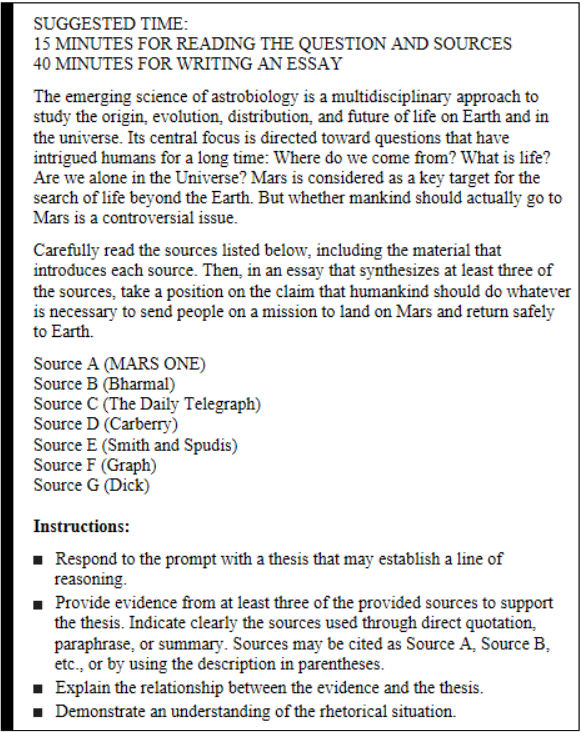
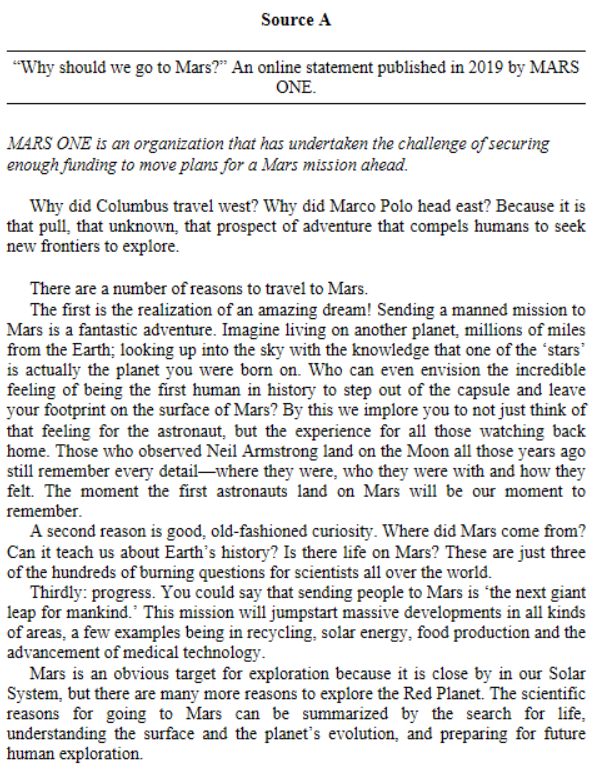
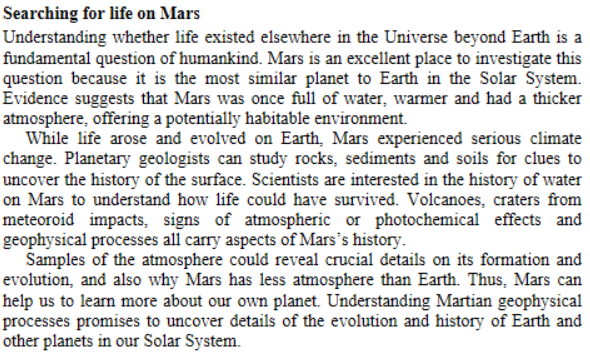
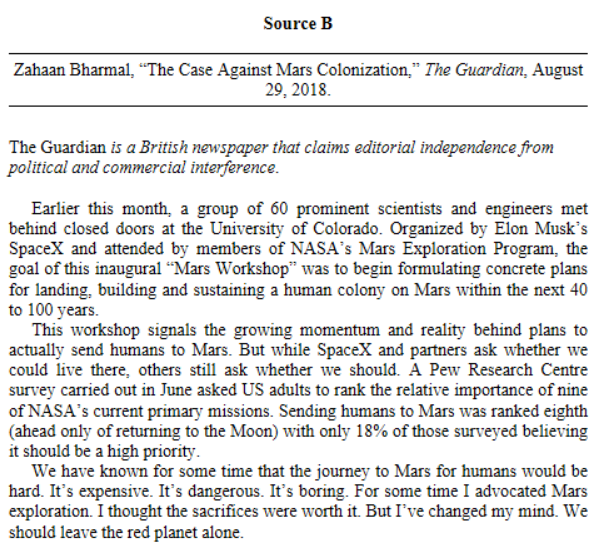
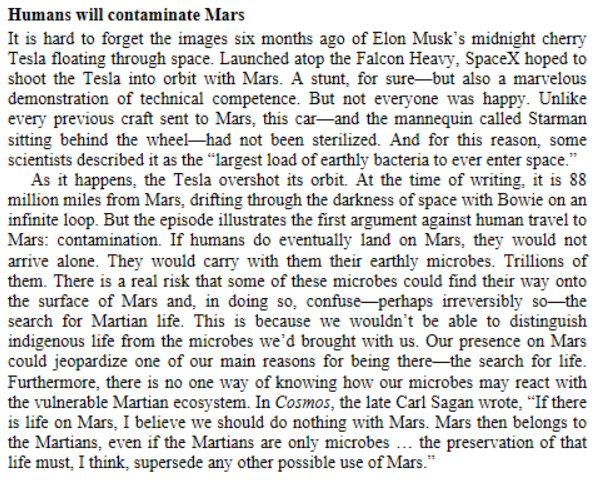
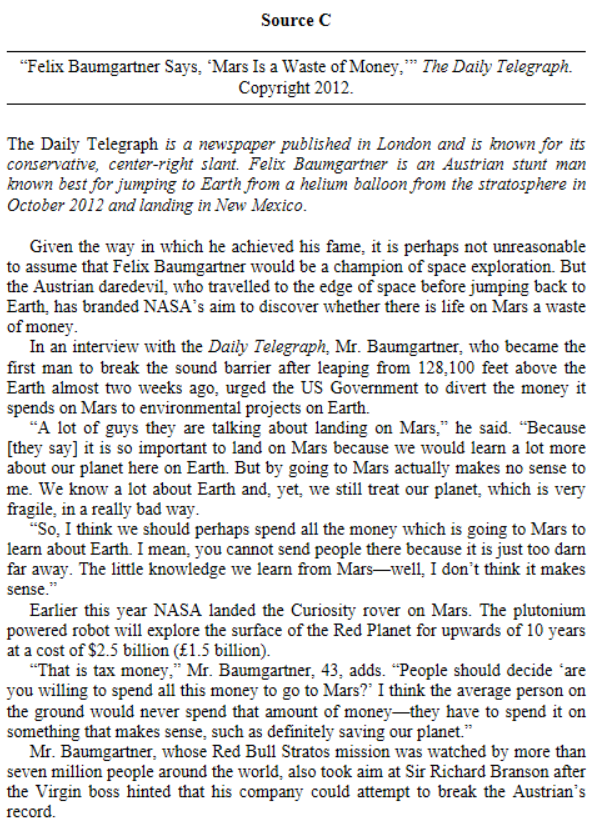
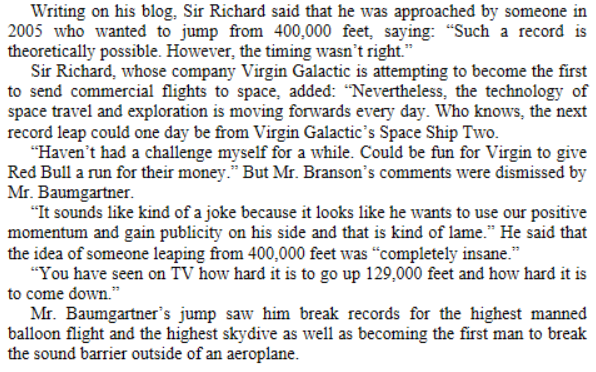
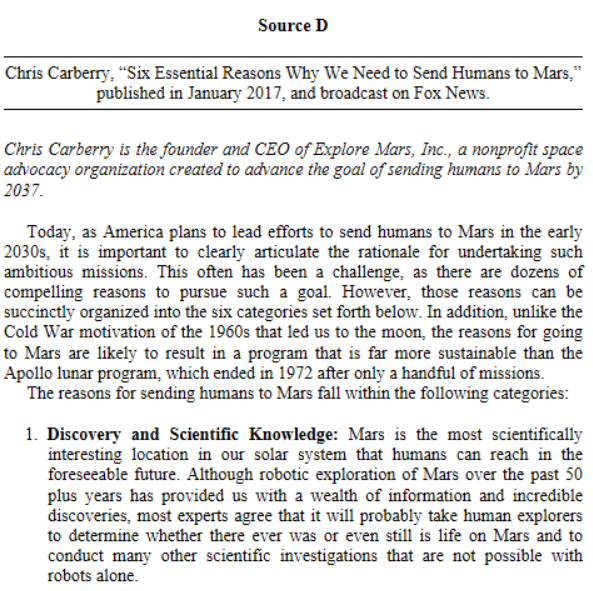
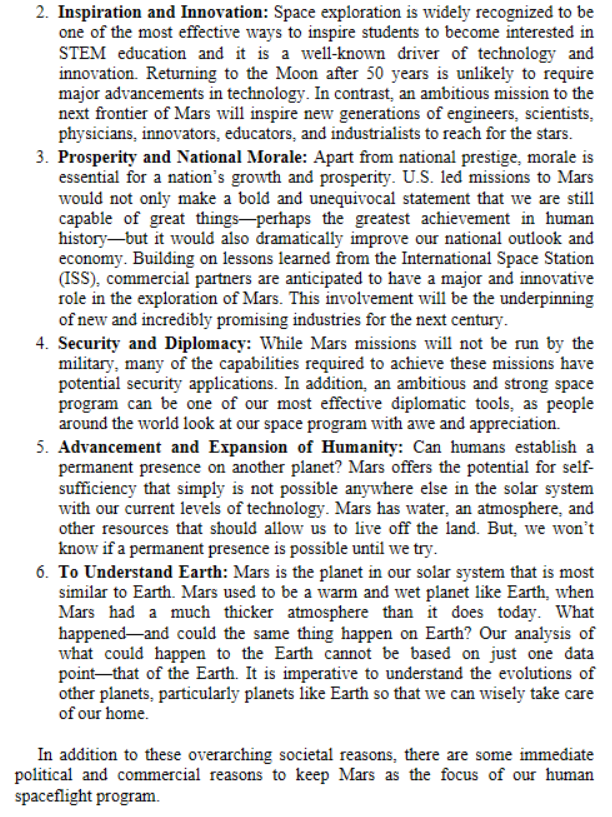
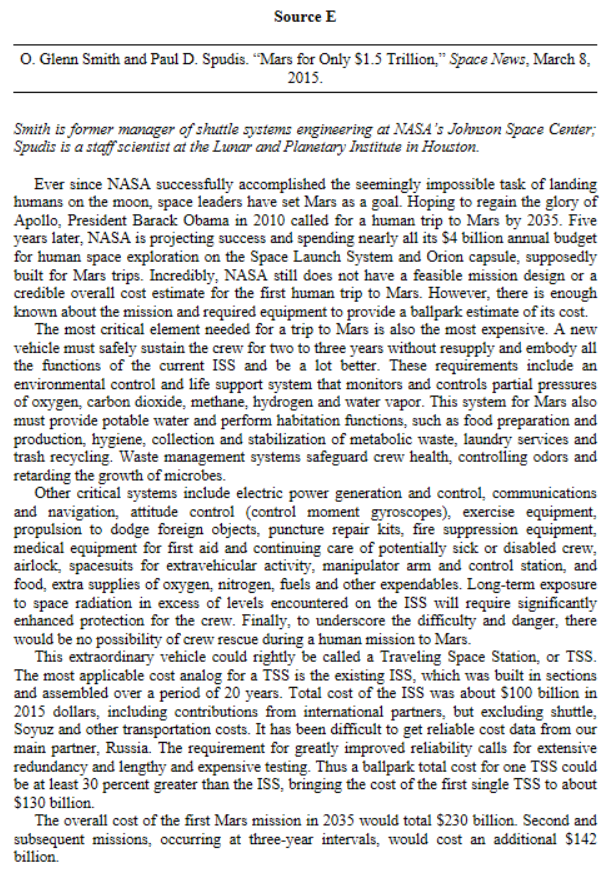
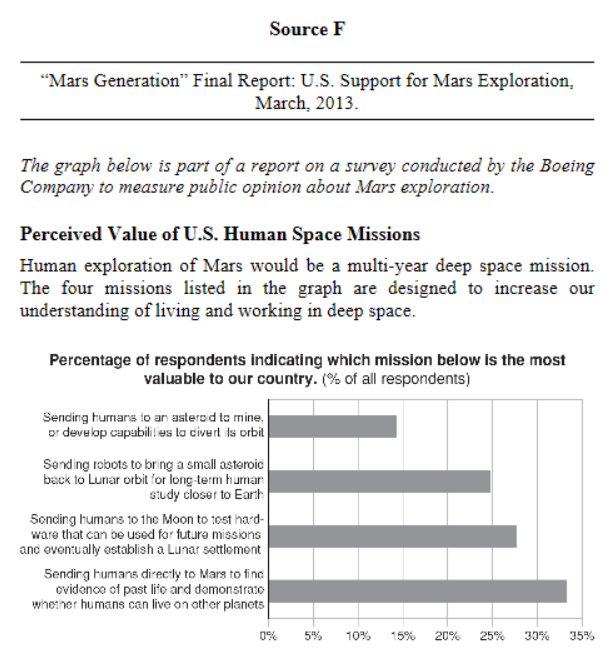
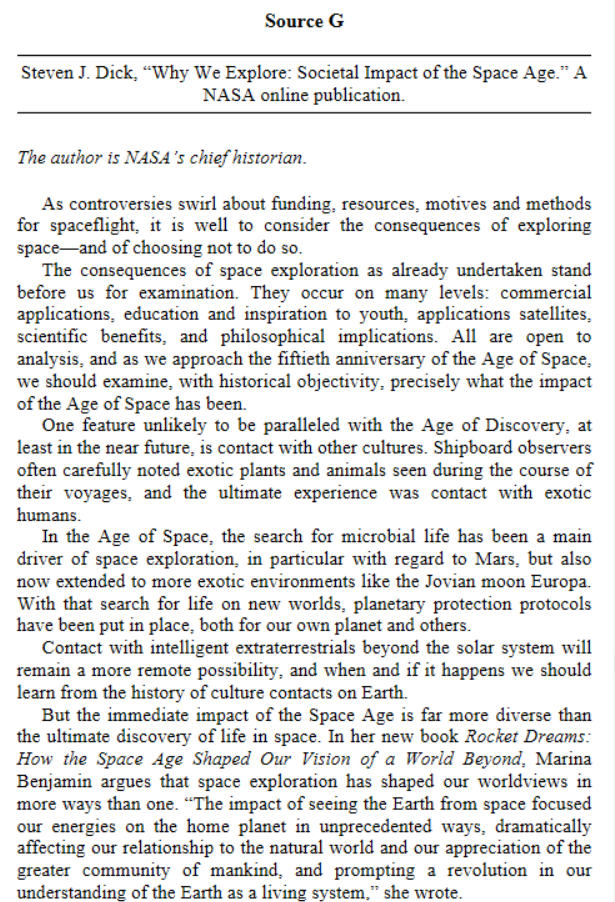
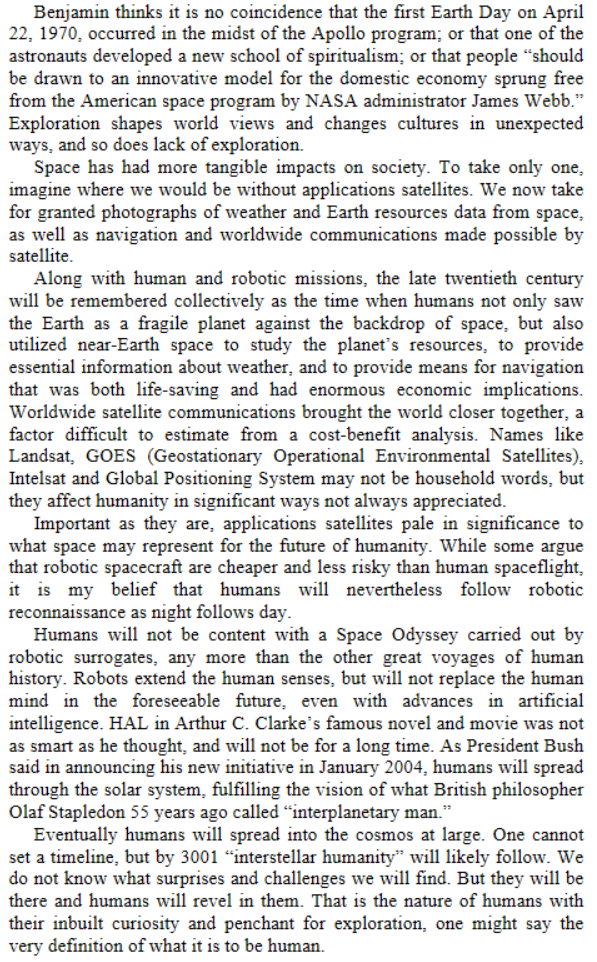
Essay Question 2
SUGGESTED TIME: 40 MINUTES
(This question counts as one-third of the total score for Section II.)

A fair and happy milkmaid is a country wench, that is so far from making herself beautiful by art, that one look of hers is able to put all outsides face-physic out of countenance. She knows a fair look is but a dumb orator to commend virtue, therefore minds it not. All her excellencies stand in her so silently, as if they had stolen upon her without her knowledge. (5)The lining of her apparel . . . is far better than the outsides of tissue: for though she be not arrayed in the spoil of the silk-worm, she is decked in innocency, a far better wearing. She doth not, with lying long abed, spoil both her complexion and conditions; nature hath taught her, too immoderate sleep is rust to the soul: she rises therefore with chanticleer, her dame’s cock, and at night makes the lamb her curfew. In milking a cow, and straining (10)the teats through her fingers, it seems that so sweet a milk-press makes the milk the whiter or sweeter; for never came almond glove or aromatic ointment on her palm to taint it. The golden ears of corn fall and kiss her feet when she reaps them, as if they wished to be bound and led prisoners by the same hand that felled them. Her breath is her own, which scents all the year long of June, like a new made haycock. She makes her hand hard with (15)labour, and her heart soft with pity: and when winter evenings fall early (sitting at her merry wheel), she sings a defiance to the giddy wheel of fortune. She doth all things with so sweet a grace, it seems ignorance will not suffer her to do ill, being her mind is to do well. She bestows her year’s wages at next fair; and in choosing her garments, counts no bravery in the world, like decency. The garden and the bee-hive are all her physic1 and chirurgery,2(20)and she lives the longer for it. She dares go alone, and unfold sheep in the night, and fears no manner of ill, because she means none: yet to say truth, she is never alone, for she is still accompanied with old songs, honest thoughts, and prayers, but short ones; yet they have their efficacy, in that they are not palled with ensuing idle cogitations. Lastly, her dreams are so chaste, that she dare tell them; only a Friday’s dream3 is all her superstition: that she (25)conceals for fear of anger. Thus lives she, and all her care is that she may die in the spring time, to have store of flowers stuck upon her winding sheet.
Essay Question 3
SUGGESTED TIME: 40 MINUTES
(This question counts as one-third of the total score for Section II.)

We thought that he was everything
To make us wish that we were in his place.
The kind of envy to which Robinson refers may serve as a strong motivating force for some people to improve their condition and place in life. On the other hand, envy may be frustrating, crippling, and destructive because it compels people to strive in vain for unattainable goals.
After considering the meaning and implications of the quotation, plan and write an essay that supports, refutes, or qualifies the claim that envy is generally an unfavorable force in people’s lives. Use evidence from your reading, studies, observations, or personal experience to develop your argument.




